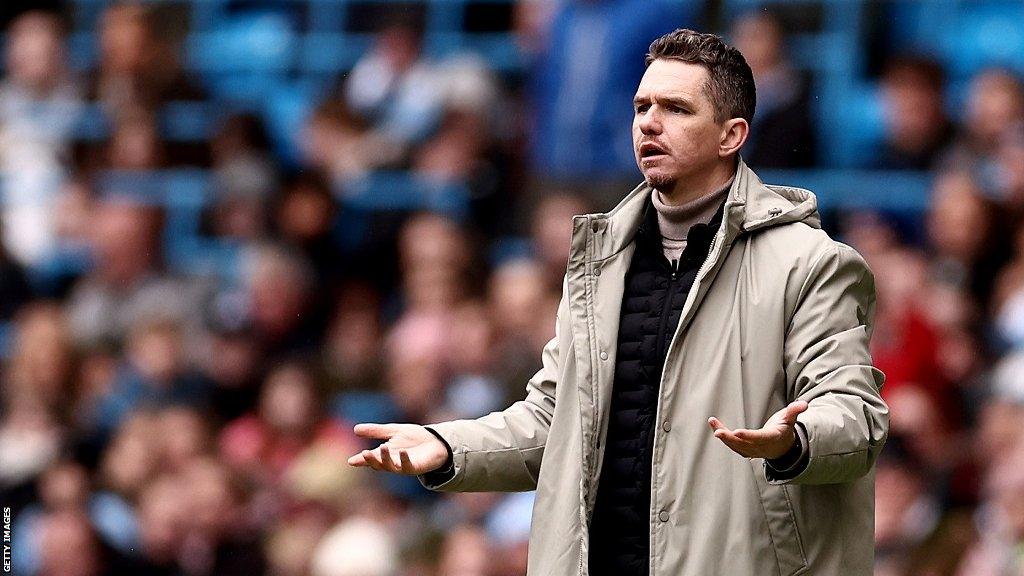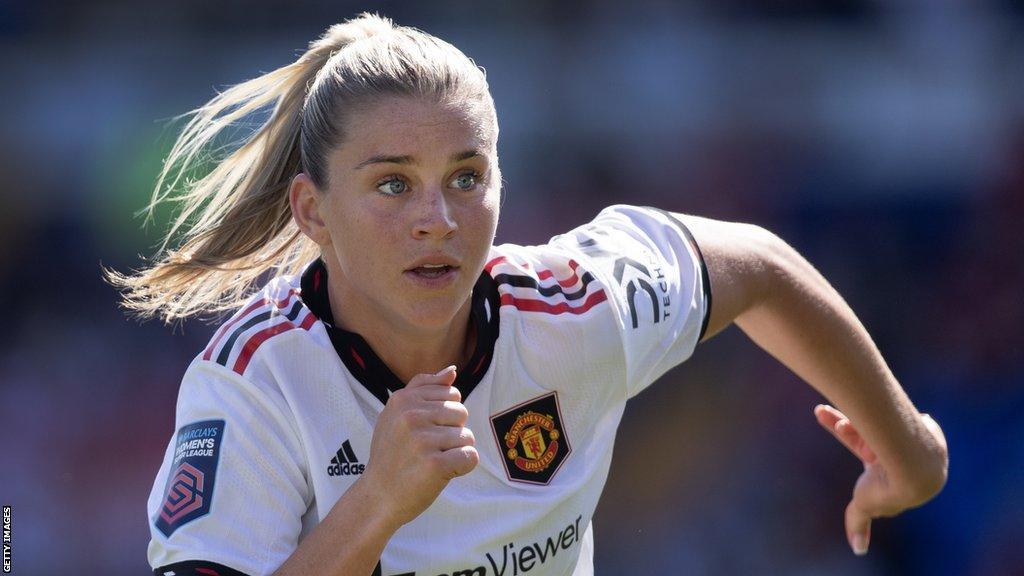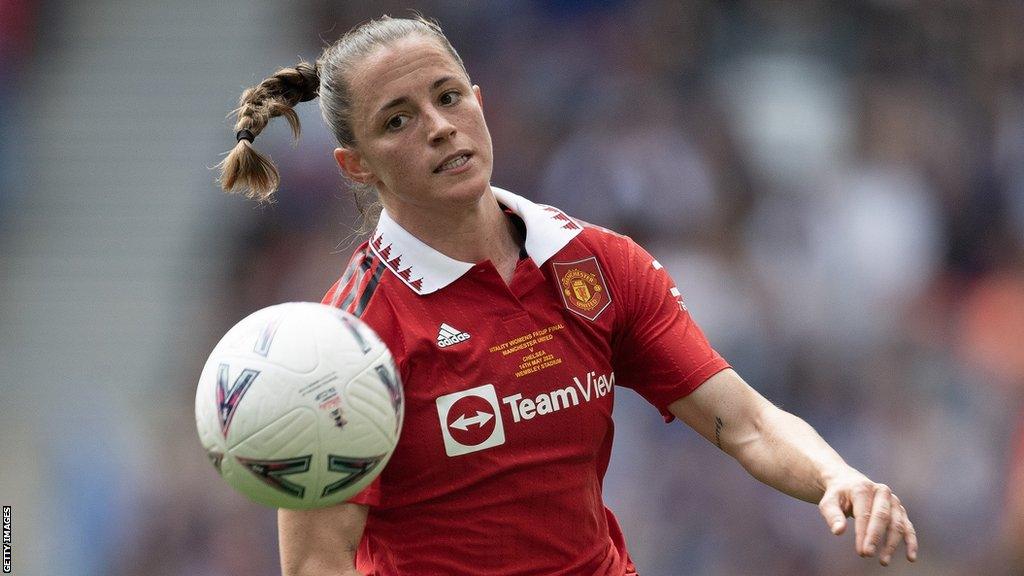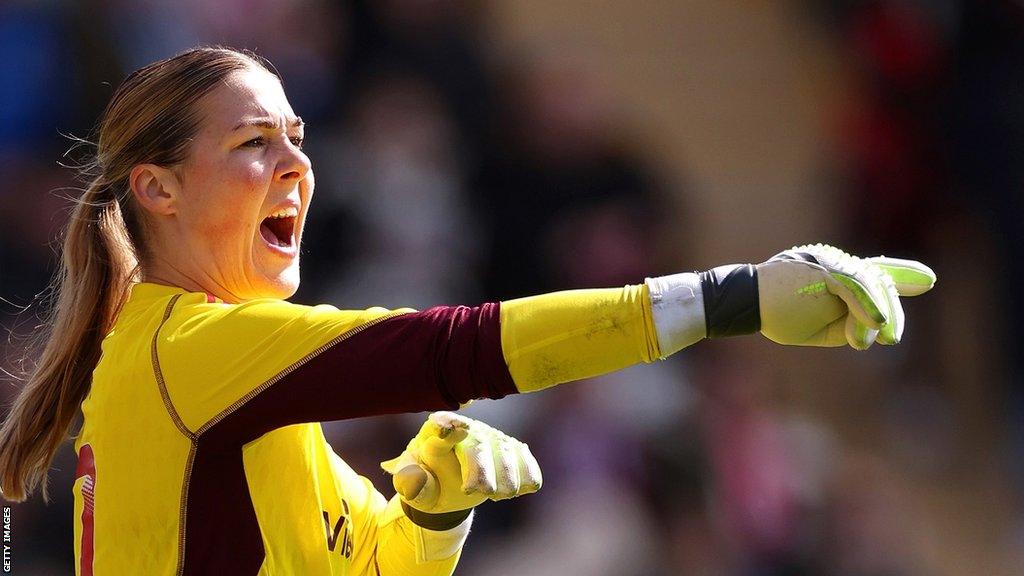Manchester United: 'All or nothing - why haven't Marc Skinner's side pushed on?'
- Published

It's all or nothing for Manchester United's season when they play their Women's FA Cup semi-final on Sunday - but why has their campaign been such a disappointment so far?
Marc Skinner's side exceeded many people's expectations in 2022-23 by finishing runners-up in the Women's Super League after challenging for the title until the final day, and qualifying for the Champions League for the first time.
This season, however, they are fourth - 15 points behind leaders Manchester City with four games to go - and look unlikely to catch third-placed Arsenal and make it back into Europe.

United have dropped points in half of their league games so far this season
It's not just United's results that have been underwhelming, it's some of their performances as well.
I wanted to explore why, so I started thinking about why they were so effective last year, and looking at how good they are at the same things now.
Why are they conceding more goals?
The most obvious area where United have dropped off since last season is at the back.
They are still scoring an average of more than two goals in every WSL game, but the rate at which they are conceding has more than doubled - from 0.55 goals per game, to 1.28.
So, something has changed somewhere and I wanted to find out where those extra opposition goals are coming from.

Skinner took charge of United in July 2021 and finished fourth in his first season
Watching their games back I saw a lot of misplaced passes, or United players being dispossessed when they were playing out, and that seemed to be an obvious area of concern.
The stats show they have got one of the slowest build-ups in the WSL - as in they play a lot of passes in their own defensive third - so they are spending a lot of time with the ball at the back and inviting the press.
But that is actually nothing new. United essentially build play the same way as they did last season, with a lot of passes in their own half and an emphasis on possession.
They are actually conceding fewer high turnovers and dispossessions this season, not more, but when they do lose the ball it is proving to be a lot more costly.
Man Utd in the WSL (and rank) | ||
|---|---|---|
Average | 2022-23 | 2023-24 |
Possession | 57% (1) | 62.4 (4) |
Passes own half per game | 271 (2) | 275 (5) |
High turnovers conceded per game | 9.1 (1) | 8.8 (3) |
Passes per shot taken | 32 (=6) | 33 (9) |
High turnovers per game | 15 (1) | 14.8 (3) |
There is a difference higher up the pitch too, where they have become less effective at pressing the opposition.
The difference is only a minor one when you look at the numbers, but it can have a big impact on results.
I would put a lot of that down to the departure of Alessia Russo to Arsenal in July, because the England striker is one of the most aggressive pressers in the women's game.
United ranked top for high turnovers last season, with Arsenal fourth, but with Russo in their team, it is the Gunners who lead that category in 2023-24.
United have missed Batlle as well as Russo

England striker Russo, 25, left United to join Arsenal on a free transfer in July
Let's not forget what United have achieved in a short space of time. The WSL has gone from a top-three to a top-four league, in terms of contenders, because of their massive title push last season, which resulted in their best league finish since they were formed in 2018.
It feels likes changes in personnel have affected their performances, more than any attempt to change the way they play.
Russo was their leading goalscorer in all competitions last season so, as well as her defensive input, United clearly miss her as a focal point to their attack and for the way she linked up so well with Ella Toone.
It is the same with the loss of Spain full-back Ona Batlle, who also left the club last summer to join Barcelona.
Jayde Riviere and Hannah Blundell have both been used at right-back instead, but losing Batlle seems to have impacted United's entire right side, going forward and back.

Spain full-back Batlle, 24, also left United on a free transfer last summer, joining European champions Barcelona in June
Blundell's defending has been criticised this season but Skinner seems to favour her overall game, particularly her progressive passing which suits the way Skinner wants United want to play.
United have still had a pretty settled defence this season - Blundell [at left-back or right-back], goalkeeper Mary Earps and centre-half duo Maya le Tissier and Millie Turner have all been ever-present in the WSL.
But, when I watch them, they don't seem as certain in their decision-making, or as consistent in their timing of tackles and the way they drop to protect space as they have done in previous seasons.
I imagine that will improve as they play more games together and their roles become more clear. But it is safe to say their attacking impact has certainly been dampened by Batlle's exit, as well as Leah Galton's limited availability this season.
How will this season be remembered?

England goalkeeper Earps has been ever-present in the WSL this season. Her United contract ends this summer
There have not been many tweaks to United's formation over the course of the campaign - far less than last season in fact, when they played in eight different shapes as opposed to three so far this time.
But, overall, United have made more changes to their whole team for league games this season - 28, compared to 18 in total in 2022-23.
On top of losing two of their most important players for the way they play, that has clearly not helped.
It has meant that United could not push on properly in their pursuit of another top-two finish and more European football, but what happens next could decide whether this period goes down as a landmark campaign, a season of transition or a backwards step.
Winning the FA Cup and securing their first trophy would be huge of course, but first they have to get past holders and favourites Chelsea on Sunday, in a repeat of last year's final.
Women's FA Cup final: Chelsea 1-0 Man Utd highlights
What is more important to the team's long-term future, however, is what happens at the end of the season.
As it stands Skinner seems set to stay in charge - talks are under way for a new deal.
But at the moment there is uncertainty over several players who are also out of contract in the summer, including Earps, captain Katie Zelem and striker Nikita Parris and, if they are going to kick on, United are going to need some stability with their squad too.
Karen Bardsley was speaking to BBC Sport's Chris Bevan.